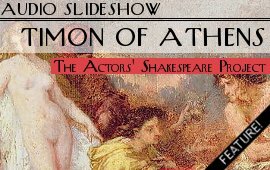With unanimously rave reviews and record-breaking box office sales, the Huntington’s is unequivocally a winner. As of October 7th, it’s the highest grossing musical in the Huntington’s history with over a million dollars in ticket sales. In the novella, one of Candide’s more cynical characters figures that out of five or six thousand thousand plays written in the French language maybe fifteen or sixteen are any good. Another critic names a figure of just over 1%, and that’s of the plays he owns! It’s already clear that Mary Zimmerman’s adaptation of the musical will be a, likely the, highlight of the season and belongs in that minority of really really good shows. Perhaps this Candide‘s recipe for success is impossible to copy, but it seems like a perfect chance to point out what can make a show successful in the reviews and at the box office, beyond it just being well done.
Revise a Classic with some History and Give People Something to Talk About
Choosing proven material like Candide by no means guarantees success. In fact, the risks a production takes on only increase the better and more loved a particular play or musical is. Critics and audiences are more likely to have seen great productions before, so they come with high expectations. Sure, familiarity is good for ticket sales (Hollywood has had that figured out for a while), but it also sparks critique, anger, and frustration in defense of a work’s “original state”–just look at the A.R.T.’s Porgy and Bess.
Debate and an energized critical discourse feed right into our larger theaters’ massive PR machines. In the same way that people went to see The Blair Witch Project to find out if the witch was real or not, people will see a show a) because everyone is talking about it, b) to see why everyone is talking about it, and c) so they know where to stand in all this talk. You have to give people something to talk about and the critics something to write.
While Candide has been wholeheartedly praised without any of the “controversy” we saw with the A.R.T’s Porgy and Bess, its production history of revisions and revivals sparks dialogue by providing an interesting context. Hugh Wheeler’s book has consistently been sent back to the chopping block throughout the operettas many revivals. It’s no surprise. While a natural choice for a musical interpretation, particularly by a composer of Bernstein’s wit, Candide is a rather unlikely candidate for the stage. It presents the technical challenges of a fast paced narrative that crosses the Atlantic twice, reading almost like a boys’ adventure novel, all while maintaining perhaps the subtlest wit in the Western canon. In short, it’s difficult to condense without spoiling everything that makes the text great. When you do it perfectly, as Zimmerman has with the Huntington, you get something that fits into the narrative of the musical’s production history, so that the show isn’t just good, it’s essential.
Choose Something with Popular Source Material
I’ve kept an eye on some of the Facebook chatter around the show and it’s clear that the Huntington has thousands of high school and University reading lists to thank for a large chunk of Candide‘s box office revenue. Theaters struggle to connect with audiences–those they have and those they wish they had. We see the historical settings of Shakespeare modernized to make them closer to the 21st century. We see programming that reflects current events and programming and revisionary productions that feature minorities. But, it’s far easier to mine the connections between theater and audiences that are already there, instead of trying to forge new ones. And as many well known plays there are, such connections are far more likely with well-read prose classics.
Candide may not be as culturally ubiquitous as Spiderman or The Lion King, but it is immensely well known and loved for its literary importance, humor, and accessibility. Knowing the source material, gives someone a reason, sometimes even a sense of obligation, to see the theatrical adaptation. It makes advertising and marketing, as well as positive reviews and newspaper previews, more effective several times over, because even just a passing glance at a poster can immediately connect the show to the love or sense of cultural value one has for the play or musical’s source. It permits more people to engage critically with the production, and makes them more likely to talk about it later. And altogether, these connections, from pre-sale marketing “touches” to individual characters, add up to a deeper sense of enjoyment. As a show does well for itself to establish a significant moment in the narrative of a production history (see above), it does even better to latch itself onto an audience member’s internal narrative of memory, engagement, and cultural discovery.
Go Dutch and Give People Their Money’s Worth
You can get in for much less with a student ID, if you’re under 35, if you buy during a sale, if you go with a group, or if you sit in the last row during previews, but generally a ticket to the Huntington runs around $80. Candide tickets went for about $20 over that. This is a reach for more most people. And most non-subscriber and new audiences want their money’s worth–even if technically, their money is worth only about half of a production. You could put on the one man show of the decade, but unless you cast a movie star, people will question the value of the ticket price. With a cast of 19 and a 14 piece orchestra Candide certainly satisfied anybody’s sense of, and need for, value.
A production as large as this, with tickets prices at about $100 or less, would not have been possible if the Huntington hadn’t split the check with Washington D.C.’s and Chicago’s . Splitting production costs means bigger shows with bigger casts with bigger names. Putting a show on the road comes with greater financial risks, but it drums up more national headlines (for all those Bostonians who read the NY Times over the Globe) and gives the show more time to flesh itself out.
Put It to Music
With the popular success of everything from High School Musical and Glee to Repo! The Genetic Opera, it’s safe to say musicals have made their comeback. Upon taking the reigns at the A.R.T., Diane Paulus looked to musical theater to bring in audiences and increase revenue. While everyone hasn’t been happy about it and there have been a few duds, it’s worked. A musical, at least one of Candide‘s scale, is something bigger than a play, more entertaining and more of an evening. It’s a show, in the truest sense of the word. Drama may pierce (or hold a mirror up to) our souls, but witty music and lyrics fill us with tenacious glee and earworms. The sheer spectacle of a musical dazzles and with their recent resurgence, they’re more likely to pull in audiences, even when they’re not imported from New York.
Fill the Kitchen Sink
Candide has just about everything: comedy, romance, opera, orchestral music, intellectual wit, adventure, history, and an affirmation of not only the meaning of life, but the means to a happy one. Much of this we owe to Voltaire’s encyclopedia of a brain, worldliness, and M.O. of slicing through just about everything with his razor sharp wit and cynicism. Appeal is crucial to commercial success, so the most successful productions are those that a lot of different people can access on a lot of different levels. Whether or not someone has seen the show before, or listened to the score, or read the book, or understood the book, Zimmerman’s production makes sure that Candide is always accessible and enjoyable. Moreover, it has something for everybody. Like a Disney Channel movie has something for the kid who likes computers, the one who likes sports, the girls who like romance, and the boys who like action, Candide fills the kitchen sink with enough plot, character, and production elements to please all.



